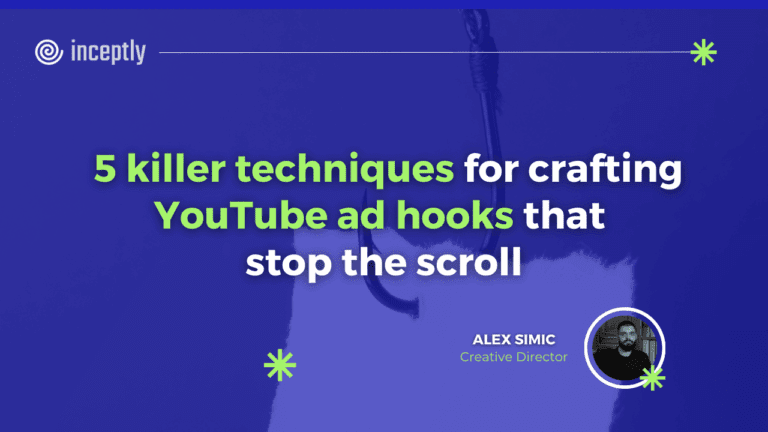
Throughout the past year or so, we’ve analyzed many successful ads that have been the absolute leaders in ad spend when it comes to direct response advertising on YouTube.
And while the ad as a whole is obviously extremely important, everybody knows how vital a good hook is to the ad’s success.
So obviously, it’s time to talk hooks. Yes, I’ve been diving deep into some of the most successful YouTube ads out there, and I’ve been talking about them separately, but let’s try to see what the common denominator is for these successful ads’ hooks.
Want to brainstorm with our team on new ways to scale your business with YouTube Ads (and other performance video platforms)?
Join us for a free YouTube ad brainstorming session👇
1. The curiosity/educational angle a.k.a 'The Content Gap'
Remember that Publishing.com ad?
“Did you know that Amazon has a $50 million fund that they have to pay out every month?”
Boom. Right out of the gate, they’re hitting you with something that seems too good to be true. It’s like they’re saying, “Hey, there’s this secret pot of gold, and I’m about to tell you how to get your hands on it.”
Why it works: It creates intrigue by claiming something seemingly unbelievable, but at the same time, it’s educating and informing the audience. Both of these things are something that the audience LOVES. This approach taps into our natural curiosity and desire for insider knowledge. It’s not just about selling a product; it’s about revealing a hidden opportunity.
The beauty of this hook is that it positions the advertiser as an expert with valuable information to share, rather than just another company trying to sell something. It’s a classic “what if” scenario that makes viewers think, “If this is true, I can’t afford to miss out on learning more.” Plus, by framing it as educational content, it bypasses our natural resistance to ads. We’re more likely to keep watching if we think we’re going to learn something valuable, even if it’s in the context of an advertisement.
2. The visual interrupt
Think about Stephen Ridley’s piano book ad.
“Stephen, is that your new book?”
It’s like we’ve just walked in on a conversation. It’s unexpected, it’s natural, and it immediately draws us in.
Why it works: It breaks the pattern of what viewers expect from an ad. It feels more like content than a sales pitch, and that’s gold when executed correctly in the direct response world. This approach leverages the power of context switching. In a sea of polished, clearly scripted ads, something that feels spontaneous and authentic immediately stands out. It’s like a pattern interrupt for the brain, forcing viewers to pay attention because what they’re seeing doesn’t fit their expectations of an ad.
Moreover, this technique creates a sense of intimacy and exclusivity. Viewers feel like they’re getting a behind-the-scenes look or being let in on a private conversation. This can be incredibly powerful in building a connection with the audience, making them more receptive to the message that follows. It’s not just about selling a book; it’s about making the viewer feel like they’re part of Stephen’s world.
3. The immediate benefit
The Organifi Green Juice ad that we’ve analyzed recently nails this.
“Every morning I take one scoop of Organifi green juice, mix it up in a glass of water, and congratulations, you just had 11 of the world’s healthiest superfoods in seven seconds of work.”
In one sentence, they’ve told you what the product is, what it does, and how easy it is to use.
Why it works: It’s clear, it’s concise, and it immediately shows the viewer what’s in it for them. This approach is all about instant gratification and solving a problem the viewer might not even know they had. It’s saying, “Here’s a simple solution to a complex problem (getting enough nutrients).” The genius of this hook is in its specificity. It’s not just saying “this is good for you” – it’s giving you exact numbers (11 superfoods) and a precise time frame (seven seconds).
This level of detail makes the claim feel more credible and the benefit more tangible. Plus, by emphasizing the ease of use, it’s addressing a common objection before it even comes up. People often think eating healthy is time-consuming or difficult, but this hook is saying, “Nope, it’s as easy as mixing a drink.” It’s a perfect example of how to present a clear value proposition in just a few seconds.
4. The personal story
“Can’t go? Do this to clear out stuck poop fast.”
While this isn’t a traditional personal story, it immediately transitions into one. The ad quickly moves to a woman sharing a vivid, personal anecdote about her mother’s emergency hospital visit due to severe constipation.
This is a great example of a personal story hook because:
It starts with a direct, attention-grabbing question that relates to a common problem.
It immediately dives into a personal, relatable story about a health emergency.
The story is specific and detailed, making it feel authentic and engaging.
Why it works: This hook combines the problem-solution setup with a personal story. It grabs attention with a bold statement, then keeps viewers engaged by sharing a relatable, somewhat shocking personal experience. It’s like the ad is saying, “This isn’t just a product pitch; this is a real problem that affects real people, and here’s a dramatic example of why it matters.”
This approach works particularly well for health-related products because it taps into viewers’ fears and concerns about their own health or the health of their loved ones. The personal story makes the problem feel more immediate and real, which in turn makes the solution (the product) feel more necessary and valuable.
So when we’re talking about personal story hooks, we’re not just limited to success stories. Sometimes, a story about a problem or a crisis can be just as effective in grabbing attention and setting up the need for your product or service.
5. The problem-solution setup
Remember that Bare Skin Tactical Hoodie ad?
“You’re not a child, you’re a man, so stop wearing so many layers to go outside.”
It’s provocative, it’s a little bit cheeky, and it immediately sets up a problem that the product is going to solve.
Why it works: It taps into identity and presents a clear problem that the viewer might not have even realized they had. This approach is brilliant on multiple levels. First, it’s using a classic marketing technique of creating a problem and then offering a solution. But it’s doing so in a way that’s tied to masculinity and identity, which adds an emotional punch to the message.
The hook is essentially saying, “If you’re doing this, you’re not living up to your full potential as a man.” It’s a bold statement that’s designed to make the viewer sit up and take notice. It’s challenging the audience, almost daring them to disagree or prove the ad wrong.
This hook is tapping into deeper insecurities and aspirations. It’s not just about staying warm; it’s about being tough, being practical, being a “real man.” By framing the problem this way, they’re turning a simple piece of clothing into a statement about identity and masculinity.
The genius of this approach is that it creates a problem that only their product can solve. They’re not just saying “our hoodie is warm” – they’re saying “our hoodie is the solution to proving and maintaining your masculinity in the face of cold weather.”
It’s also worth noting the use of contrast here. By comparing the viewer to a child, they’re setting up a clear dichotomy: either you’re a child who needs lots of layers, or you’re a man who uses their product. This kind of black-and-white thinking can be very effective in advertising because it simplifies the decision-making process for the viewer.
Lastly, the slightly cheeky, provocative tone of this hook is perfect for their target audience. It feels like something one guy might say to another, which helps it come across as authentic rather than preachy.
This type of hook works particularly well for products that are trying to create a new category or change existing behaviors. It’s not just selling a product; it’s selling a new way of thinking about an everyday problem. And that’s powerful stuff in the world of direct response advertising.
Now, here’s the kicker – the best hooks often try to combine two or more of these techniques. It’s not easy, or even necessary to do, and these 5 types of hooks are not the only ones existing in the world, but they are a good reminder of what works, and why we assume that it does work.
Remember, your hook has one job: to stop the scroll and keep viewers watching. It needs to be punchy, intriguing, and immediately relevant to your target audience.
So, next time you’re crafting a YouTube ad, ask yourself:
Are you creating curiosity?
Is there something visually or audibly unexpected?
Are you presenting an immediate, clear benefit?
Can you lead with a relatable, personal story?
Are you addressing a problem your audience faces?
Hit one or more of these points in your hook, and you’ll be well on your way to creating YouTube ads that don’t just get views but drive real results.
And hey, if you’re feeling stuck trying to nail that perfect hook, you know where to find us. We’re always pumped to help businesses create YouTube ads that crush it.
Want to brainstorm with our team on new ways to scale your business with YouTube Ads (and other performance video platforms)?
Join us for a free YouTube ad brainstorming session:
Want more content like this?
Don’t miss out on the latest news and updates from the world of Direct Response advertising! Subscribe to our newsletter today 👇

Alex Simic, Creative Director
Alex Simic is the person responsible for all creative work that stands behind Inceptly since stepping into his role in 2022. He comes from the role of the Media Buying Team Lead and Strategist behind some of Inceptly’s biggest successes. He has collaborated with the biggest names in the Direct Response industry, whether as a Senior Account Manager & Media Buyer or Creative Director. His main goal is bridging the gap between Media Buying and Creative, ensuring that the videos Inceptly produces are data-based and giving our clients the best chance at achieving success.
Like this post? Let's continue the conversation!
Get in touch with us by shooting us a quick email or tagging us on LinkedIn or Instagram, and sharing your thoughts. Your feedback helps us keep our blog relevant and interesting.
Get Our Newsletter
Need Help?
Get in touch with us for an insightful evaluation of your ads + actionable tips to help amp up your direct response revenue








